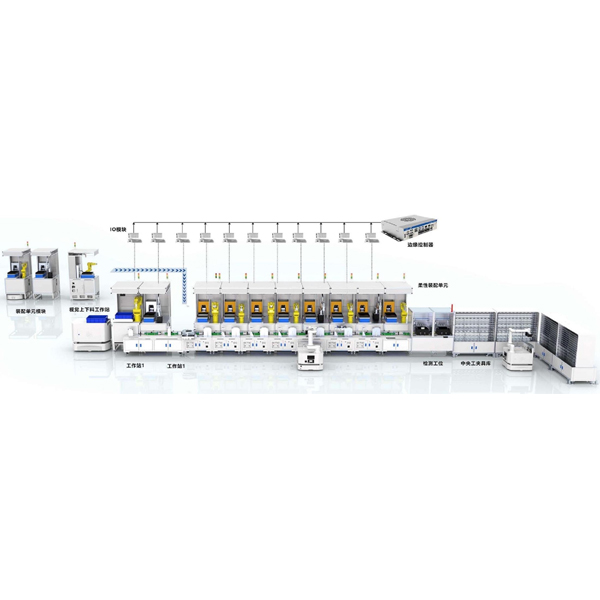Key Features and Applications of Industrial Robot
2024-05-28
An industrial robot, also known as a robotic arm or automation robot, is a programmable mechanical device used in manufacturing and industrial settings to perform various tasks autonomously or semi-autonomously. These robots are designed to handle repetitive, hazardous, or complex tasks with precision and efficiency, ultimately improving productivity and safety in industrial operations.
Key Features
1. Robotic Arm:
- Manipulator: Consists of multiple joints and links that mimic the movements of a human arm, allowing the robot to reach and manipulate objects in its workspace.
- End Effector: The tool or gripper attached to the end of the robotic arm, used to grasp, lift, and manipulate objects.
2. Sensors and Vision Systems:
- Position Sensors: Provide feedback on the robot's position and orientation, ensuring accuracy and precision in its movements.
- Vision Systems: Cameras and sensors that enable the robot to perceive and interact with its environment, including object recognition and tracking capabilities.
3. Programming Interface:
- Offline Programming: Software tools that allow programmers to create and simulate robot programs without direct interaction with the physical robot.
- Teach Pendant: Handheld devices with intuitive interfaces that enable operators to program and control the robot directly.
4. Safety Features:
- Safety Interlocks: Sensors and mechanisms that prevent collisions and ensure safe operation in proximity to human workers.
- Emergency Stop: A quick-stop button or switch that halts robot motion in emergency situations to prevent accidents.
5. Integration with Automation Systems:
- Communication Protocols: Interfaces that allow the robot to communicate with other machines, controllers, and manufacturing systems.
- Collaborative Robots (Cobots): Robots designed to work alongside humans in a shared workspace, offering flexibility and safety in collaborative tasks.
Applications
1. Material Handling:
- Pick and Place: Transferring items from one location to another, such as loading and unloading parts on assembly lines.
- Palletizing and Packaging: Arranging products on pallets and packaging them for shipment in warehouses and distribution centers.
2. Assembly and Manufacturing:
- Assembly Operations: Performing tasks such as fastening, welding, and soldering in manufacturing processes.
- Quality Inspection: Inspecting products for defects or deviations from specifications using sensors and vision systems.
3. Welding and Cutting:
- Arc Welding: Joining metal parts together using robotic welding systems for increased precision and consistency.
- Laser Cutting: Utilizing robotic arms equipped with lasers to cut materials with high accuracy and speed.
4. Painting and Finishing:
- Spray Painting: Applying paint or coatings to surfaces evenly and efficiently in automotive, aerospace, and other industries.
- Surface Finishing: Polishing, deburring, and buffing parts to achieve desired surface textures and finishes.
5. Material Removal and Machining:
- Grinding and Deburring: Removing excess material and smoothing surfaces using robotic grinding and deburring systems.
- CNC Machining: Operating machine tools such as milling machines and lathes to fabricate complex parts with precision.
Advantages
1. Increased Productivity: Robots can work continuously without breaks or fatigue, leading to higher output and throughput in manufacturing operations.
2. Improved Quality and Consistency: Precise control and repeatability ensure consistent results and reduce errors and defects in production processes.
3. Enhanced Safety: Robots can perform hazardous tasks in potentially dangerous environments, protecting human workers from injury and exposure to risks.
4. Cost Savings: While initial investment costs may be high, the long-term benefits of increased efficiency and reduced labor costs often justify the investment in industrial robots.
5. Flexibility and Scalability: Robots can be reprogrammed and reconfigured to adapt to changing production needs, offering flexibility and scalability in manufacturing operations.
Challenges and Considerations
1. Initial Investment and Integration Costs: Acquiring and implementing industrial robots involves significant upfront costs for equipment, installation, and training.
2. Programming and Maintenance: Skilled personnel are needed to program, operate, and maintain robotic systems, requiring ongoing training and support.
3. Compatibility and Interoperability: Ensuring compatibility and seamless integration with existing automation systems and equipment can be challenging.
4. Safety Concerns: Proper risk assessment and safety protocols are essential to prevent accidents and ensure safe operation in shared workspaces.
5. Ethical and Social Implications: Concerns about job displacement and the impact on the workforce require careful consideration and planning in the adoption of industrial robots.
Future Trends
1. Advanced Robotics Technologies: Continued advancements in robotics, artificial intelligence, and machine learning will drive innovation and enable robots to perform increasingly complex tasks with greater autonomy.
2. Collaborative Robotics: The rise of collaborative robots (cobots) will enable closer human-robot interaction and cooperation in shared workspaces, expanding the potential applications of industrial robots.
3. Mobile Robotics: Mobile robots equipped with navigation and localization capabilities will enable autonomous material transport and logistics operations in warehouses and factories.
4. Industry 4.0 and Smart Manufacturing: Integration with Industry 4.0 technologies such as IoT, big data analytics, and cloud computing will enable smarter and more connected manufacturing systems with enhanced efficiency and agility.
5. Sustainability and Green Robotics: Emphasis on energy efficiency, recycling, and environmentally friendly manufacturing practices will drive the development of eco-friendly robotic systems and processes.
Industrial robots play a crucial role in modern manufacturing and industrial automation, offering a wide range of benefits in terms of productivity, quality, safety, and cost-effectiveness. As technology continues to evolve, industrial robots will remain essential tools for driving innovation and competitiveness in the global marketplace.



